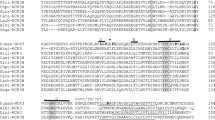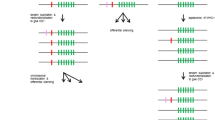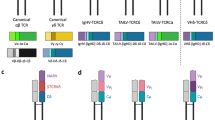Abstract
Natural killer (NK) cells play major roles in innate immunity against viruses and cancer. Natural killer receptors (NKR) expressed by NK cells recognize foreign- or self-ligands on infected and transformed cells as well as healthy cells. NKR genes are the most rapidly evolving loci in vertebrates, and it is generally difficult to detect orthologues in different taxa. The unique exception is NKp30, an activating NKR in mammals that binds to the self-ligand B7H6. The NKp30-encoding gene, NCR3, has been found in most vertebrates including sharks, the oldest vertebrates with human-type adaptive immunity. NCR3 has a special, non-rearranging VJ-type immunoglobulin superfamily (IgSF) domain that predates the emergence of the rearranging antigen receptors. Herein we show that NCR3 loci are linked to the shark major histocompatibility complex (MHC), proving NCR3’s primordial association with the MHC. We identified eight subtypes of differentially expressed highly divergent shark NCR3 family genes. Using in situ hybridization, we detected one subtype, NS344823, to be expressed by predominantly single cells outside of splenic B cell zones. The expression by non-B cells was also confirmed by PCR in peripheral blood lymphocytes. Surprisingly, high expression of NS344823 was detected in the thymic cortex, demonstrating NS344823 expression in developing T cells. Finally, we show for the first time that shark T cells are found as single cells or in small clusters in the splenic red pulp, also unassociated with the large B cell follicles we previously identified.






Similar content being viewed by others
Data availability
All sequences had been deposited to GenBank (accession numbers MT914154-MT914170). Reagents generated from these studies are available to the public upon request.
References
Allcock RJ, Barrow AD, Forbes S, Beck S, Trowsdale J (2003) The human TREM gene cluster at 6p21.1 encodes both activating and inhibitory single IgV domain receptors and includes NKp44. Eur J Immunol 33:567–577
Arnon TI, Achdout H, Levi O, Markel G, Saleh N, Katz G, Gazit R, Gonen-Gross T, Hanna J, Nahari E, Porgador A, Honigman A, Plachter B, Mevorach D, Wolf DG, Mandelboim O (2005) Inhibition of the NKp30 activating receptor by pp65 of human cytomegalovirus. Nat Immunol 6:515–523
Bartl S, Baish MA, Flajnik MF, Ohta Y (1997) Identification of class I genes in cartilaginous fish, the most ancient group of vertebrates displaying an adaptive immune response. J Immunol 159:6097–6104
Binici J, Hartmann J, Herrmann J, Schreiber C, Beyer S, Guler G, Vogel V, Tumulka F, Abele R, Mantele W, Koch J (2013) A soluble fragment of the tumor antigen BCL2-associated athanogene 6 (BAG-6) is essential and sufficient for inhibition of NKp30 receptor-dependent cytotoxicity of natural killer cells. J Biol Chem 288:34295–34303
Brandt CS, Baratin M, Yi EC, Kennedy J, Gao Z, Fox B, Haldeman B, Ostrander CD, Kaifu T, Chabannon C, Moretta A, West R, Xu W, Vivier E, Levin SD (2009) The B7 family member B7–H6 is a tumor cell ligand for the activating natural killer cell receptor NKp30 in humans. J Exp Med 206:1495–1503
Cantoni C, Bottino C, Vitale M, Pessino A, Augugliaro R, Malaspina A, Parolini S, Moretta L, Moretta A, Biassoni R (1999) NKp44, a triggering receptor involved in tumor cell lysis by activated human natural killer cells, is a novel member of the immunoglobulin superfamily. J Exp Med 189:787–796
Castro CD, Ohta Y, Dooley H, Flajnik MF (2013) Non-coordinate expression of J-chain and Blimp-1 define nurse shark plasma cell populations during ontogeny. Eur J Immunol
Chen R, Zhang L, Qi J, Zhang N, Zhang L, Yao S, Wu Y, Jiang B, Wang Z, Yuan H, Zhang Q, Xia C (2018) Discovery and analysis of invertebrate IgVJ-C2 structure from amphioxus provides insight into the evolution of the Ig superfamily. J Immunol 200:2869–2881
Correia MP, Stojanovic A, Bauer K, Juraeva D, Tykocinski LO, Lorenz HM, Brors B, Cerwenka A (2018) Distinct human circulating NKp30(+)FcepsilonRIgamma(+)CD8(+) T cell population exhibiting high natural killer-like antitumor potential. Proc Natl Acad Sci U S A 115:E5980–E5989
Criscitiello MF, Ohta Y, Saltis M, McKinney EC, Flajnik MF (2010) Evolutionarily conserved TCR binding sites, identification of T cells in primary lymphoid tissues, and surprising trans-rearrangements in nurse shark. J Immunol 184:6950–6960
Du Pasquier L, Zucchetti I, De Santis R (2004) Immunoglobulin superfamily receptors in protochordates: before RAG time. Immunol Rev 198:233–248
Flajnik MF (2016) Evidence of G.O.D’.s miracle: unearthing a RAG transposon. Cell 166:11–12
Flajnik MF (2018) A cold-blooded view of adaptive immunity. Nat Rev Immunol 18:438–453
Flajnik MF, Miller K, Du Pasquier L (2003) Evolution of the immune system. In Paul WE (ed.) Fundamental immunology, Fifth edn. Lippencott Williams & Wilkins, Philadelphia
Flajnik MF, Tlapakova T, Criscitiello MF, Krylov V, Ohta Y (2012) Evolution of the B7 family: co-evolution of B7H6 and NKp30, identification of a new B7 family member, B7H7, and of B7’s historical relationship with the MHC. Immunogenetics 64:571–590
Fu Y, Yang Z, Huang J, Cheng X, Wang X, Yang S, Ren L, Lian Z, Han H, Zhao Y (2019) Identification of two nonrearranging IgSF genes in chicken reveals a novel family of putative remnants of an antigen receptor precursor. J Immunol 202:1992–2004
Greenwald RJ, Freeman GJ, Sharpe AH (2005) The B7 family revisited. Annu Rev Immunol 23:515–548
Hara Y, Yamaguchi K, Onimaru K, Kadota M, Koyanagi M, Keeley SD, Tatsumi K, Tanaka K, Motone F, Kageyama Y, Nozu R, Adachi N, Nishimura O, Nakagawa R, Tanegashima C, Kiyatake I, Matsumoto R, Murakumo K, Nishida K, Terakita A, Kuratani S, Sato K, Hyodo S, Kuraku S (2018) Shark genomes provide insights into elasmobranch evolution and the origin of vertebrates. Nat Ecol Evol 2:1761–1771
Hofmann J, Greter M, Du Pasquier L, Becher B (2010) B-cells need a proper house, whereas T-cells are happy in a cave: the dependence of lymphocytes on secondary lymphoid tissues during evolution. Trends Immunol 31:144–153
Hudspeth K, Silva-Santos B, Mavilio D (2013) Natural cytotoxicity receptors: broader expression patterns and functions in innate and adaptive immune cells. Front Immunol 4:69
Humphrey MB, Lanier LL, Nakamura MC (2005) Role of ITAM-containing adapter proteins and their receptors in the immune system and bone. Immunol Rev 208:50–65
Jarahian M, Fiedler M, Cohnen A, Djandji D, Hammerling GJ, Gati C, Cerwenka A, Turner PC, Moyer RW, Watzl C, Hengel H, Momburg F (2011) Modulation of NKp30- and NKp46-mediated natural killer cell responses by poxviral hemagglutinin. PLoS Pathog 7:e1002195
Jones DT, Taylor WR, Thornton JM (1992) The rapid generation of mutation data matrices from protein sequences. Comput Appl Biosci 8:275–282
Joyce MG, Tran P, Zhuravleva MA, Jaw J, Colonna M, Sun PD (2011) Crystal structure of human natural cytotoxicity receptor NKp30 and identification of its ligand binding site. Proc Natl Acad Sci U S A 108:6223–6228
Kasahara M, Canel C, McKinney EC, Flajnik MF (1991) Molecular cloning of nurse shark cDNAs with high sequence similarity to nucleoside diphosphate kinase genes. In J K (ed.) Evolution of the major histocompatibility complex. Springer-Verlag, New York, NY
Kruse PH, Matta J, Ugolini S, Vivier E (2014) Natural cytotoxicity receptors and their ligands. Immunol Cell Biol 92:221–229
Kumar S, Stecher G, Li M, Knyaz C, Tamura K (2018) MEGA X: molecular evolutionary genetics analysis across computing platforms. Mol Biol Evol 35:1547–1549
Lanier LL, Corliss BC, Wu J, Leong C, Phillips JH (1998) Immunoreceptor DAP12 bearing a tyrosine-based activation motif is involved in activating NK cells. Nature 391:703–707
Li SS, Ogbomo H, Mansour MK, Xiang RF, Szabo L, Munro F, Mukherjee P, Mariuzza RA, Amrein M, Vyas JM, Robbins SM, Mody CH (2018) Identification of the fungal ligand triggering cytotoxic PRR-mediated NK cell killing of Cryptococcus and Candida. Nat Commun 9:751
Li Y, Wang Q, Mariuzza RA (2011) Structure of the human activating natural cytotoxicity receptor NKp30 bound to its tumor cell ligand B7–H6. J Exp Med 208:703–714
Long EO (2008) Negative signaling by inhibitory receptors: the NK cell paradigm. Immunol Rev 224:70–84
Luo M, Kim H, Kudrna D, Sisneros NB, Lee SJ, Mueller C, Collura K, Zuccolo A, Buckingham EB, Grim SM, Yanagiya K, Inoko H, Shiina T, Flajnik MF, Wing RA, Ohta Y (2006) Construction of a nurse shark (Ginglymostoma cirratum) bacterial artificial chromosome (BAC) library and a preliminary genome survey. BMC Genomics 7:106
Mebius RE, Kraal G (2005) Structure and function of the spleen. Nat Rev Immunol 5:606–616
Neely HR, Flajnik MF (2016) Emergence and evolution of secondary lymphoid organs. Annu Rev Cell Dev Biol 32:693–711
Neely HR, Guo J, Flowers EM, Criscitiello MF, Flajnik MF (2018) “Double-duty” conventional dendritic cells in the amphibian Xenopus as the prototype for antigen presentation to B cells. Eur J Immunol 48:430–440
Ohta Y, Flajnik MF (2015) Coevolution of MHC genes (LMP/TAP/class Ia, NKT-class Ib, NKp30-B7H6): lessons from cold-blooded vertebrates. Immunol Rev 267:6–15
Ohta Y, Goetz W, Hossain MZ, Nonaka M, Flajnik MF (2006) Ancestral organization of the MHC revealed in the amphibian Xenopus. J Immunol 176:3674–3685
Ohta Y, Kasahara M, O’Connor TD, Flajnik MF (2019) Inferring the “primordial immune complex”: origins of MHC Class I and antigen receptors revealed by comparative genomics. J Immunol 203:1882–1896
Ohta Y, McKinney EC, Criscitiello MF, Flajnik MF (2002) Proteasome, transporter associated with antigen processing, and class I genes in the nurse shark Ginglymostoma cirratum: evidence for a stable class I region and MHC haplotype lineages. J Immunol 168:771–781
Ohta Y, Shiina T, Lohr RL, Hosomichi K, Pollin TI, Heist EJ, Suzuki S, Inoko H, Flajnik MF (2011) Primordial linkage of {beta}2-microglobulin to the MHC. J Immunol 186:3563–3571
Pazina T, Shemesh A, Brusilovsky M, Porgador A, Campbell KS (2017) Regulation of the functions of natural cytotoxicity receptors by interactions with diverse ligands and alterations in splice variant expression. Front Immunol 8:369
Pende D, Parolini S, Pessino A, Sivori S, Augugliaro R, Morelli L, Marcenaro E, Accame L, Malaspina A, Biassoni R, Bottino C, Moretta L, Moretta A (1999) Identification and molecular characterization of NKp30, a novel triggering receptor involved in natural cytotoxicity mediated by human natural killer cells. J Exp Med 190:1505–1516
Pessino A, Sivori S, Bottino C, Malaspina A, Morelli L, Moretta L, Biassoni R, Moretta A (1998) Molecular cloning of NKp46: a novel member of the immunoglobulin superfamily involved in triggering of natural cytotoxicity. J Exp Med 188:953–960
Pettey CL, McKinney EC (1983) Temperature and cellular regulation of spontaneous cytotoxicity in the shark. Eur J Immunol 13:133–138
Pettinello R, Redmond AK, Secombes CJ, Macqueen DJ, Dooley H (2017) Evolutionary history of the T cell receptor complex as revealed by small-spotted catshark (Scyliorhinus canicula). Dev Comp Immunol 74:125–135
Rumfelt LL, Avila D, Diaz M, Bartl S, McKinney EC, Flajnik MF (2001) A shark antibody heavy chain encoded by a nonsomatically rearranged VDJ is preferentially expressed in early development and is convergent with mammalian IgG. Proc Natl Acad Sci U S A 98:1775–1780
Rumfelt LL, McKinney EC, Taylor E, Flajnik MF (2002) The development of primary and secondary lymphoid tissues in the nurse shark Ginglymostoma cirratum: B-cell zones precede dendritic cell immigration and T-cell zone formation during ontogeny of the spleen. Scand J Immunol 56:130–148
Sakano H, Huppi K, Heinrich G, Tonegawa S (1979) Sequences at the somatic recombination sites of immunoglobulin light-chain genes. Nature 280:288–294
Session AM, Uno Y, Kwon T, Chapman JA, Toyoda A, Takahashi S, Fukui A, Hikosaka A, Suzuki A, Kondo M, van Heeringen SJ, Quigley I, Heinz S, Ogino H, Ochi H, Hellsten U, Lyons JB, Simakov O, Putnam N, Stites J, Kuroki Y, Tanaka T, Michiue T, Watanabe M, Bogdanovic O, Lister R, Georgiou G, Paranjpe SS, van K, I, Shu S, Carlson J, Kinoshita T, Ohta Y, Mawaribuchi S, Jenkins J, Grimwood J, Schmutz J, Mitros T, Mozaffari SV, Suzuki Y, Haramoto Y, Yamamoto TS, Takagi C, Heald R, Miller K, Haudenschild C, Kitzman J, Nakayama T, Izutsu Y, Robert J, Fortriede J, Burns K, Lotay V, Karimi K, Yasuoka Y, Dichmann DS, Flajnik MF, Houston DW, Shendure J, DuPasquier L, Vize PD, Zorn AM, Ito M, Marcotte EM, Wallingford JB, Ito Y, Asashima M, Ueno N, Matsuda Y, Veenstra GJ, Fujiyama A, Harland RM, Taira M, Rokhsar DS (2016) Genome evolution in the allotetraploid frog Xenopus laevis. Nature 538:336–343
Stafford JL, Bengten E, Du PL, McIntosh RD, Quiniou SM, Clem LW, Miller NW, Wilson M (2006) A novel family of diversified immunoregulatory receptors in teleosts is homologous to both mammalian Fc receptors and molecules encoded within the leukocyte receptor complex. Immunogenetics 58:758–773
Stet RJ, Hermsen T, Westphal AH, Jukes J, Engelsma M, BM LV-vK, Dortmans J, Aveiro J, Savelkoul HF (2005) Novel immunoglobulin-like transcripts in teleost fish encode polymorphic receptors with cytoplasmic ITAM or ITIM and a new structural Ig domain similar to the natural cytotoxicity receptor NKp44. Immunogenetics 57:77–89
Terado T, Okamura K, Ohta Y, Shin DH, Smith SL, Hashimoto K, Takemoto T, Nonaka MI, Kimura H, Flajnik MF, Nonaka M (2003) Molecular cloning of C4 gene and identification of the class III complement region in the shark MHC. J Immunol 171:2461–2466
Thompson CB (1995) New insights into V(D)J recombination and its role in the evolution of the immune system. Immunity 3:531–539
Tonegawa S (1983) Somatic generation of antibody diversity. Nature 302:575–581
Venkatesh B, Kirkness EF, Loh YH, Halpern AL, Lee AP, Johnson J, Dandona N, Viswanathan LD, Tay A, Venter JC, Strausberg RL, Brenner S (2007) Survey sequencing and comparative analysis of the elephant shark (Callorhinchus milii) genome. PLoS Biol 5:e101
Venkatesh B, Lee AP, Ravi V, Maurya AK, Lian MM, Swann JB, Ohta Y, Flajnik MF, Sutoh Y, Kasahara M, Hoon S, Gangu V, Roy SW, Irimia M, Korzh V, Kondrychyn I, Lim ZW, Tay BH, Tohari S, Kong KW, Ho S, Lorente-Galdos B, Quilez J, Marques-Bonet T, Raney BJ, Ingham PW, Tay A, Hillier LW, Minx P, Boehm T, Wilson RK, Brenner S, Warren WC (2014) Elephant shark genome provides unique insights into gnathostome evolution. Nature 505:174–179
Vitale M, Cantoni C, Della Chiesa M, Ferlazzo G, Carlomagno S, Pende D, Falco M, Pessino A, Muccio L, De Maria A, Marcenaro E, Moretta L, Sivori S (2019) An historical overview: the discovery of how NK cells can kill enemies, recruit defense troops, and more. Front Immunol 10:1415
Williams AF, Barclay AN (1988) The immunoglobulin superfamily–domains for cell surface recognition. Annu Rev Immunol 6:381–405
Yoder JA, Litman GW (2011) The phylogenetic origins of natural killer receptors and recognition: relationships, possibilities, and realities. Immunogenetics 63:123–141
Yoder JA, Mueller MG, Wei S, Corliss BC, Prather DM, Willis T, Litman RT, Djeu JY, Litman GW (2001) Immune-type receptor genes in zebrafish share genetic and functional properties with genes encoded by the mammalian leukocyte receptor cluster. Proc Natl Acad Sci U S A 98:6771–6776
Funding
MEJ and JK were supported by the University of Maryland Scholars Program, an initiative of the University of Maryland: MPowering the State. MFF and YO are supported by National Institutes of Health Grants AI140-326-27 and AI02877. MFC was supported by National Science Foundation Grants IOS 1257829 and IOS-1656870.
Author information
Authors and Affiliations
Contributions
Three authors, Allison Kinlein, Morgan E. James, and Jacob Kincer, share the first authorship. The study conception and design were conducted by Martin Flajnik and Yuko Ohta. Material preparation, data collection, and analysis were performed by all authors. The first draft of the manuscript was written by Morgan Janes and further modified by Yuko Ohta and Martin Flajnik. All authors commented on the manuscript preparation and approved the final edits.
Corresponding author
Ethics declarations
Ethics approval
All procedures performed in studies involving animals were approved by Institutional Animal Care and Use Committee (IACUC) at University of Maryland.
Conflict of interest
The authors declare that they have no conflict of interest.
Additional information
Publisher’s Note
Springer Nature remains neutral with regard to jurisdictional claims in published maps and institutional affiliations.
Supplementary Information
Below is the link to the electronic supplementary material.
Rights and permissions
About this article
Cite this article
Kinlein, A., Janes, M.E., Kincer, J. et al. Analysis of shark NCR3 family genes reveals primordial features of vertebrate NKp30. Immunogenetics 73, 333–348 (2021). https://doi.org/10.1007/s00251-021-01209-6
Received:
Accepted:
Published:
Issue Date:
DOI: https://doi.org/10.1007/s00251-021-01209-6




